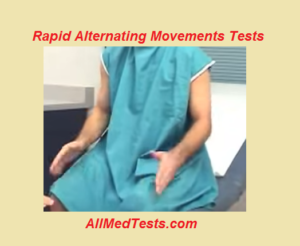There are different diseases and disturbances in the body which can be detected with the help of different tests. Ataxia, lateral cerebellum, and different other diseases are examined with the help of different tests. We name them Rapid Alternating Movement Tests. There are many tests in this series some of which we have already explained before. Today, I am also going to mention those tests along with a new RAM test. Well, as in the previous articles, I have mentioned again and again that these tests can be performed and better results can be obtained by doing under the supervision of a good doctor. However, if you manage yourself to learn these tests by reading articles and watching videos, you can do it yourself as well. But, make sure that you visit your doctor again to confirm the results you have obtained from this self-experimentation.

A Standard Rapid Alternating Movement Test Procedure:
One of the standard rapid alternating movement tests can be performed in the given way written below.
- Make your patient sit on a chair in a normal posture.
- Now ask him to place both of his hands on the respective thighs.
- Now tell him to change the place of his hands on the opposite thighs respectively which is left hand on the right thigh and right hand on the left thigh.
- The patients must do this in quick succession at least for 10 seconds.
After, this the doctor will make the final examination. You can learn it better by watching a video given below. I have got to mention once again that you must go to the doctor for the final observation you have made with the help of your assistant below. Now watch the video embedded below for better learning purposes.
Heel-to-Shin Test:
This is the standard procedure of performing the heel-to-shin test. As I have already mentioned that the procedure may change based on doctor’s experience or the type of disease he wants to detect. Also, a video is embedded after this step by step written guide for your better understanding so make sure that you read and watch carefully. Let us move on with our test now.
- While doing the heel-to-shin test, on the opposite knee, the heel of one foot should be touched.
- Now this heel which is touched to the opposite knee, the patient will be asked to drag it all the way towards the shin.
- After this, the heel must be dragged back to its previous position.
Note: To have this test performed better in order to give better results, reduce the effect of gravity. This is done by performing this test in the supine position, which is the best position agreed upon by all the physicians. Once after all these steps, your heel-to-shin has just been performed successfully. Watch the video embedded below for the better learning of this test.
Learn about Heel To Shin Test in detail.
Finger-to-Nose Test:
Just like the heel-to-shin test which I taught you in an article before, this test is quite easy to perform. However, I must mention here again that this test is best performed under the doctor’s supervision of the better examination of disease. Also, the way of performing this test may differ according to the doctor you choose based on his experience etc. Also, a video link is embedded after this written procedure to perform this test which will help you to understand this test in a better way. Let us now guide you through the procedure of performing this test in few easy steps.
- In this test, the patient is required to quickly touch their noses and the fingers of the examiner as fast and quick as they can.
- Always keep in mind that the finger which patient will use to touch his/her nose and doctor finger should be right index finger.
- The patient must do it as fast as possible and the doctor has to change the position of its finger during the test.
- If the patient can do this as fast as he can with his left finger at the rate he does with his right finger then the patient is normal. If not, then this means that the patient is abnormal.
And this is how we easily perform this test and get the results.
Learn about Finger To Nose Test in detail.
Final Words:
I really hope that this article helped you a great deal about these tests. You can ask any question about the test if you have in the comment section. Don’t forget to leave us your feedback and keep visiting All Med Tests for more interesting scientific tests.






Leave a Reply